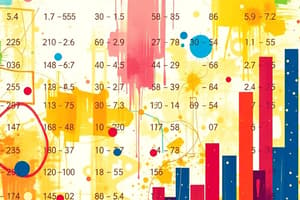Podcast
Questions and Answers
What is the primary focus of the field of statistics?
What is the primary focus of the field of statistics?
- Forming hypotheses and designing experiments
- Developing new statistical methodology
- Making sense of data arising from random processes or phenomena (correct)
- Collecting and analyzing data
What is the main difference between mathematical statistics and applied statistics?
What is the main difference between mathematical statistics and applied statistics?
- Mathematical statistics is used for data analysis, while applied statistics is used for data collection
- Mathematical statistics focuses on theory, while applied statistics focuses on real-world problems (correct)
- Mathematical statistics is more theoretical, while applied statistics is more practical
- Mathematical statistics deals with biology, while applied statistics deals with health sciences
What is a data set?
What is a data set?
- A collection of observations of random variables (correct)
- A sample of a population
- A single observation of a random variable
- A population of all possible values of a variable
What is the difference between a quantitative variable and a qualitative variable?
What is the difference between a quantitative variable and a qualitative variable?
What is a population in statistics?
What is a population in statistics?
What is the primary focus of biostatistics?
What is the primary focus of biostatistics?
What is an example of a qualitative variable?
What is an example of a qualitative variable?
What is the primary goal of summarizing data?
What is the primary goal of summarizing data?
What is a variable in statistics?
What is a variable in statistics?
What is the difference between a sample and a population?
What is the difference between a sample and a population?
Flashcards are hidden until you start studying
Study Notes
Statistics and Biostatistics
- Statistics is the study and use of theory and methods for the analysis of data arising from random processes or phenomena.
- It involves making sense of data and provides fundamental tools and techniques of the scientific method.
- Statistics involves:
- Forming hypotheses
- Designing experiments and observational studies
- Gathering data
- Summarizing data
- Drawing inferences from data and testing hypotheses
Divisions of Statistics
- Mathematical Statistics: studies and develops statistical theory and methods in the abstract.
- Applied Statistics: applies statistical methods to solve real problems involving randomly generated data and develops new statistical methodology motivated by real problems.
Biostatistics
- Biostatistics is the branch of applied statistics directed towards applications in the health sciences and biology.
- It involves the application of statistical methods to solve problems in health sciences and biology.
Data and Variables
- Data: observations of random variables made on the elements of a population or sample.
- Data can be quantities, numbers, or qualities, attributes measured or observed, and collected and/or analyzed.
- A collection of data is often called a data set.
- Variables:
- Can be quantitative (measurable): heart rate, heights, weight, age, size of tumor, volume of a dose.
- Can be qualitative (categorical): gender, race, drug name, disease status.
Populations and Samples
- A population: the collection or set of all of the values that a variable may have.
- A sample: a part of a population.
Studying That Suits You
Use AI to generate personalized quizzes and flashcards to suit your learning preferences.




